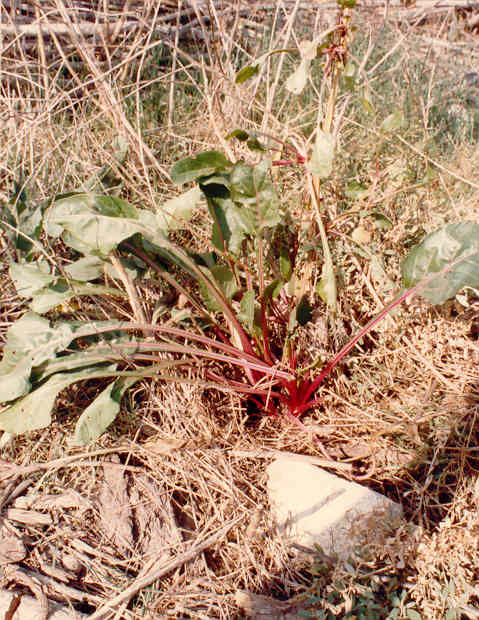
Beta vulgaris L.
Chenopodiaceae (Goosefoot Family)
Europe
 |
Beta vulgaris L.Chenopodiaceae (Goosefoot Family)Europe
BeetSugar BeetGarden Beet |
May Photo
Plant Characteristics:
Glabrous biennial herb with large fleshy roots; stems 3-12 dm. tall,
paniculately branched above; lvs. alternate, the basal rosulate, large,
long-petioled, 1-2 dm. long, ovate-oblong, the upper reduced and subsessile;
fls. perfect in glomerules of 3 or more, in panicled spikes; calyx 5-parted, the
segms. indurate and closed in fr., ca. 2 mm. long; ovary sunk in the succulent
base of the calyx; styles 2-3; fr. ca. 2.5 mm. long, somewhat wider, ultimately
opening by a lid; seeds horizontal, smooth, roundish.
Habitat:
Escaping from gardens and sometimes natur. in low damp places.
July-Oct.
Name:
Perhaps Celtic, bett, red,
because of the red roots. (Munz, Flora So. Calif. 359). Vulgaris
means common. (Jaeger 283).
General:
Common in the study area. Plants
with red stems are unusual as most have green stems; the photograph with the red
stems was taken on the Santa Ana Heights flats, other photos were taken at 23rd
Street, the Santa Ana Heights flats and on the west side of the Delhi Ditch. (my
comments). Swiss
chard was the Beta of ancient times.
The red form was named by Aristotle.
The sugar beet was the start of an industry in France in 1811, much
promoted by Napoleon. Today sugar
beets are a major source of sugar in Calif. and Swiss Chard is found in most
super markets. The red beet root is
also a familiar vegetable. Leaves
may be gathered most of the year and used fresh or cooked.
(Clarke 184). B.
vulgaris has been known to accumulate free nitrates and oxalates in
quantities capable of causing death or distress in cattle.
(Fuller 385).
Five or more species of the Old World.
(Munz, Flora So. Calif. 359 ).
Text Ref:
Hickman, Ed. 506; Munz, Calif.
Flora 368; Munz, Flora So. Calif.
359.
Photo Ref:
May 1 83 # 5,6; Oct-Nov 83 # 11,12; April-May 84 # 12,13.
Identity: by R. De Ruff,
confirmed by F. Roberts.
First Found: May 1983.
Computer Ref: Plant Data 221.
Have plant specimen.
Last edit 3/3/05.
 |
 |